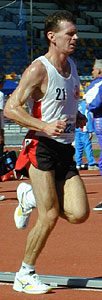Our Sponsor, SDKsupplies

It is due to the factors that make running such an efficient form of exercise that it is also highly stressful on the muscular and skeletal structures. When running, the individual is not only weight-bearing, they are actually imparting a stress to the body of up to three times their body weight on every foot strike. In order to propel the body forward with every stride the body's muscular system must be able to generate immense forces. It therefore would benefit most athletes to be knowledgeable in how to prevent injuries associated with running, as well as how to treat common running injuries and how to maintain a high degree of fitness if running related injuries occur.
As noted, distance running delivers great forces of stress to the body through impact with the ground. It is this impact stress which accounts for the majority of running injuries. The nature of these injuries and the manner in which they occur give them the categorization of overuse injuries. This category of injury therefore occurs over a prolonged period of time due to repeated bouts of overstress. There are many injuries that runners incur of the acute nature as well, yet the majority, come from the overuse category. The typical scenario eliciting injury is one in which the intensity or quantity of training is increased at such a rate that it overloads the “physiological mechanisms of adaptation". It is this cumulative overload that leads to the insidious onset of injury, and it requires a continual air of suspicion when increasing training, in order to ensure early detection of problems. With early detection the severity of injury and the degree of rehabilitation required can be significantly reduced.
As with any sport and the injuries that may be incurred, there is a great degree of chance present with ones involvement with distance running. There is always the possibility for unique or somewhat different injuries and runners seem to almost seek out these possibilities at times. However, the focus of this series of articles will remain with those injuries deemed most common to distance runners due to the inherent requirements or stresses of the activity. As has been stated previously, the causative factor for most running related injuries comes from the enormous stress imposed with impact to the ground. It seems obvious then that the vast majority of injuries that runners incur would present from the waist down or in the lower limbs.
Many studies have narrowed down the injuries that appear most frequently with runners. These common injuries have then been labeled specifically or been placed into a category of injuries that have various sites of occurrence. Although the labeling may vary slightly depending on the authority referred to, the following injuries or injury categories are the ones considered most common to runners. Stress reactions and fractures, Iliotibial Band Friction Syndrome, Patellofemoral Pain Syndrome, Achilles Tendinitis, Plantar Fascitis, and Exertional Compartment Syndromes.
Next issue we will look at the first of these injury categories: Stress Reactions and/or Fractures.
His website is: http://www.deepwaterexercise.com/